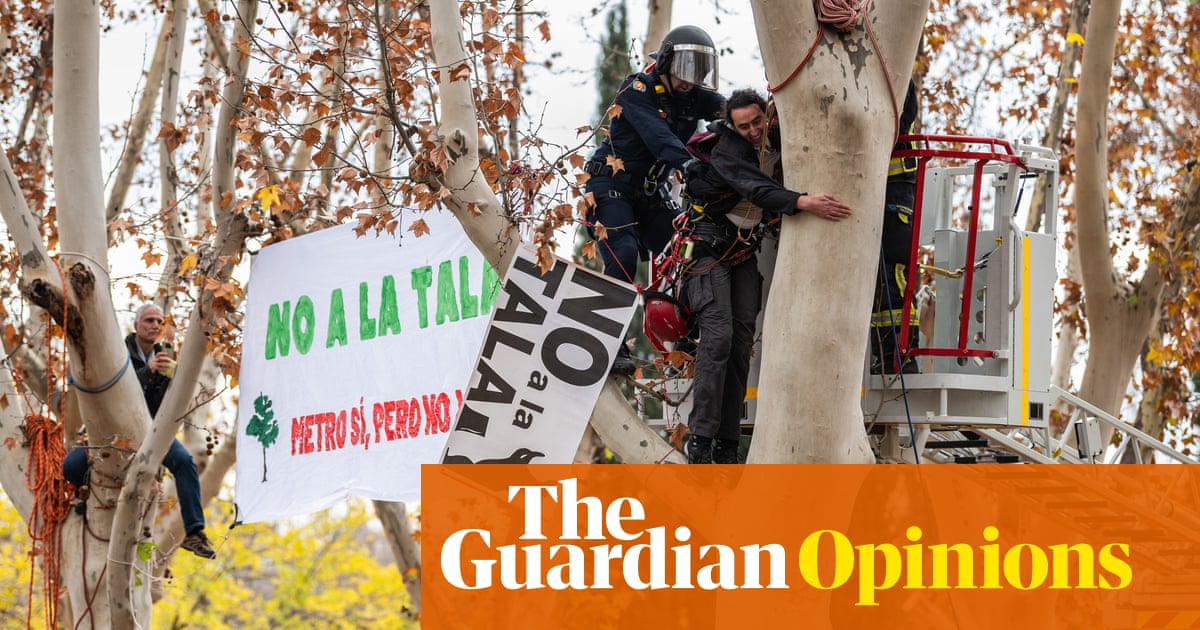It’s 9pm on a blistering July night in Plaza de Santa Ana, a square at the heart of Madrid’s literary district. The thermometer has barely dropped below 39C, but despite the heat a 78-year-old woman climbs on to a bench to give an impassioned speech to a 200-strong crowd.
“Did you think we weren’t going to be here, Señor Almeida?” She scans the crowd, searching for José Luis Martínez-Almeida, Madrid’s mayor, while anguished cries of “Arboricida!” (tree murder) punctuate the silence. Her face is immediately recognisable. She is movie star Marisa Paredes, an actor immortalised in Almodóvar classics such as High Heels – just one of many activists trying to stop what seems like a concerted campaign to strip central Madrid of its trees.
Watching a recording of Paredes’s fiery speech, I tear up, amazed at her courage. Like many others, I’ve fled the city for the summer, unable to bear the extreme heat. Madrid is one of the worst heat islands in the world, and its foliage offers a welcome reprieve from unbearable temperatures. But in a move reminiscent of the recent decision in Sheffield to deploy chainsaw-wielding workers to remove trees in the early hours, Almeida’s administration seems to be banking on locals being away to strip Santa Ana of 85% of its tree coverage.
The fight to preserve urban tree coverage is a story with increasingly high stakes being played out across the globe from Malta to Hyderabad as locals show extraordinary courage standing up against the interests of big business to demand livable cities. In Madrid, the burning issue has been its city squares, where remodelling work over the past few years has transformed once communal spaces into inhospitably hot concrete expanses that drive tourists straight into the next air-conditioned shop.
The issue came to a head in 2023, when plans to build an extension to a metro train line were altered to require the removal of more than 1,000 trees, many in public parks near Madrid’s rewilded riverside. Tired of having their needs ignored by the council, locals came out in force to protest. And it worked: while many trees were lost, just under half those earmarked for removal were saved.
But this time, despite opposition, the council hasn’t let up. When the €6.1m (£5.2m) deal to renovate the underground car park beneath Santa Ana went to private contractor Grupo Ortiz, it hastily earmarked trees for removal. The mayor justified this work as necessary due to localised damp problems in the car park – but that is flimsy at best. In a city centre where locals are priced out of the housing market by tourist apartments, who needs residential parking?
Even more pressingly, we know tree coverage saves lives. EU research indicates that increasing the tree canopy in urban areas could save hundreds of lives each summer, especially in countries such as Italy, Croatia, Romania and Spain. It’s a relatively inexpensive but effective measure – and with heat deaths in Madrid having risen to 1,308 during the brutally hot summer of 2022, it feels particularly pertinent.
There are, of course, other interests at work. Grupo Ortiz stands to make huge profits managing the car park, while the city council also saves itself some cash: it’s much cheaper to rip trees out of the urban fabric and plant saplings far out of town. “There’s money behind all this. The government in Madrid is doing everything it can to encourage more gentrification and more tourism, devastating absolutely everything,” as activist Dolores Méndez of No a la Tala (No to Felling) puts it.
This might explain the administration’s heavy-handed approach to protesters in the city. Méndez was fined last year as police forcibly removed activists from trees to allow work on the new metro to start. In defiance of legislation against peaceful protest, she didn’t pay her fine, which has now doubled to €601. Meanwhile, total fines for activists in the city amount to more than €19,000. No a la Tala will be fighting the case in court. Its members will be hoping that not all justice systems are as harsh towards those fighting for the planet as the UK’s, which handed down chillingly harsh sentences to Just Stop Oil protesters in July.
Madrid’s hellishly hot summer also sees a dangerous series of legislative changes being rushed through that could scrap a law demanding that trees that are cut down be replaced – a prelude for more unchecked construction work. Sure enough, upcoming plans to build a Formula One track in the city might well involve further destruction, as will plans to build a new transport interchange near the riverside.
Back in Plaza de Santa Ana, protests have gathered momentum while rumours swirl that the trees could go at any point. When leafage started to brown, locals discovered that irrigation systems had been switched off and began lugging buckets of water out in the blistering heat to keep the trees alive.
At the 11th hour, the incredible resilience of Paredes and activists such as Méndez won out. Two weeks ago, work was halted as the local government agreed to pause proceedings until September and hold talks with residents’ associations. As with the riverside protest, activists have vowed not to let up. While we still mourn the wholesale destruction, every tree saved provides hope to other people around the globe that these fights can be won.
